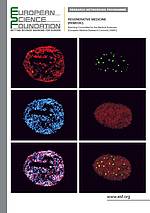NEWS
A White Paper written by the organising committee following the Final Conference, May 2013 (click on the programme) is planned to be published it in Tissue Engineering.
The REMEDIC programme officially ended on 30 April 2013 and no more activities or grants are anymore funded.
Click on the Executive Summary
- REMEDIC external website
- Second Edition of the REMEDIC leaflet (December 2009)
Summary
 |
Regenerative medicine, a rapidly evolving and exciting field, can be defined as the process of creating living, functional tissues to repair or replace tissue or organ function lost due to age, disease, damage, or congenital defects. This can be done through a variety of approaches including the replacement of tissue function with synthetic constructs (artificial organs) and using cellular therapies such as stem cells or genetically modified cells to generate new tissues and organs.
Recent advances in stem cell technologies, including for example the ability to induce human pluripotent stem (iPS) cells, mark a new era for regenerative medicine. Stem cells have an almost unlimited proliferation potential accompanied by an ability to differentiate. Thus, hematopoietic stem cells (HSCs – that give rise to the various blood cell types, including neutrophils and erythrocytes) and mesenchymal stem (or stromal) cells (MSCs – that give rise to many cell types, including adipocytes and chondrocytes) form an essential element in regenerative (or reparative) medicine, including guided regeneration.
As our knowledge advances, the frontiers of regenerative medicine are rapidly expanding. Regenerative medicine provides new insights in areas including cellular proliferation, effects of humoral and matrix signalling on cells, angiogenesis, tissue remodelling, naïve and adaptive immunity and other basic processes in cell biology. Still, regenerative medicine is in its infancy and to advance progress in this important field, national funding agencies from 14 European countries have joined forces to launch a cross-disciplinary Research Networking Programme, REMEDIC, to identify where the frontiers and future needs are in this complex multidisciplinary high-technology field, by networking researchers and clinicians across Europe.
Aims
1. To facilitate the exchange of ideas and know-how across disciplines in the area of mesenchymal (stromal) and other stem cells;
2. To review the regulatory laws, rules and standards governing the use of regenerative medicine;
3. To map the unmet population, academia and company needs in regenerative medicine and the current R&D resources (e.g. instruments, analysis techniques);
4. To assist researchers in the field of regenerative medicine in preparing cross-disciplinary coordinated research projects.
* For detailed information on the image shown above, please use the reference indicated in the REMEDIC Brochure, pg 2.
Duration
Five years, from May 2008 to April 2013 (06-RNP-128).


